Abstract
It has long been recognised that intensive efforts are needed to reform medical education in order to meet the future needs of populations worldwide. Pressure for changes to the organisation, content and delivery of both undergraduate and postgraduate medical education has greatly increased in the last two decades. The experience of innovative medical schools, the emergence of learner-centred teaching methods and the implications of health-care reforms in North America and Britain are major factors influencing calls for change. The pace of change has accelerated to such an extent in recent years that progress towards widespread reform appears to be more attainable than ever before. This article provides an overview of the changing context of health-care, some patterns of existing medical education and some strategies for change.
Full text
PDF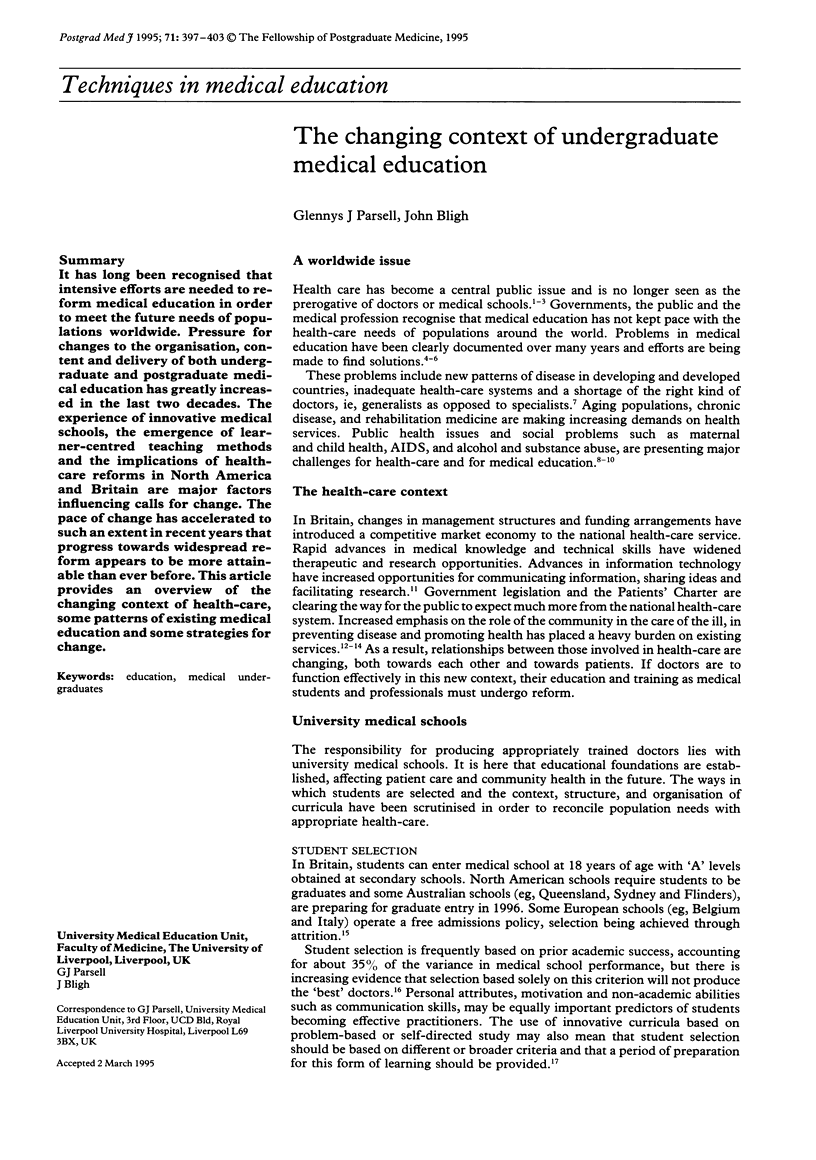
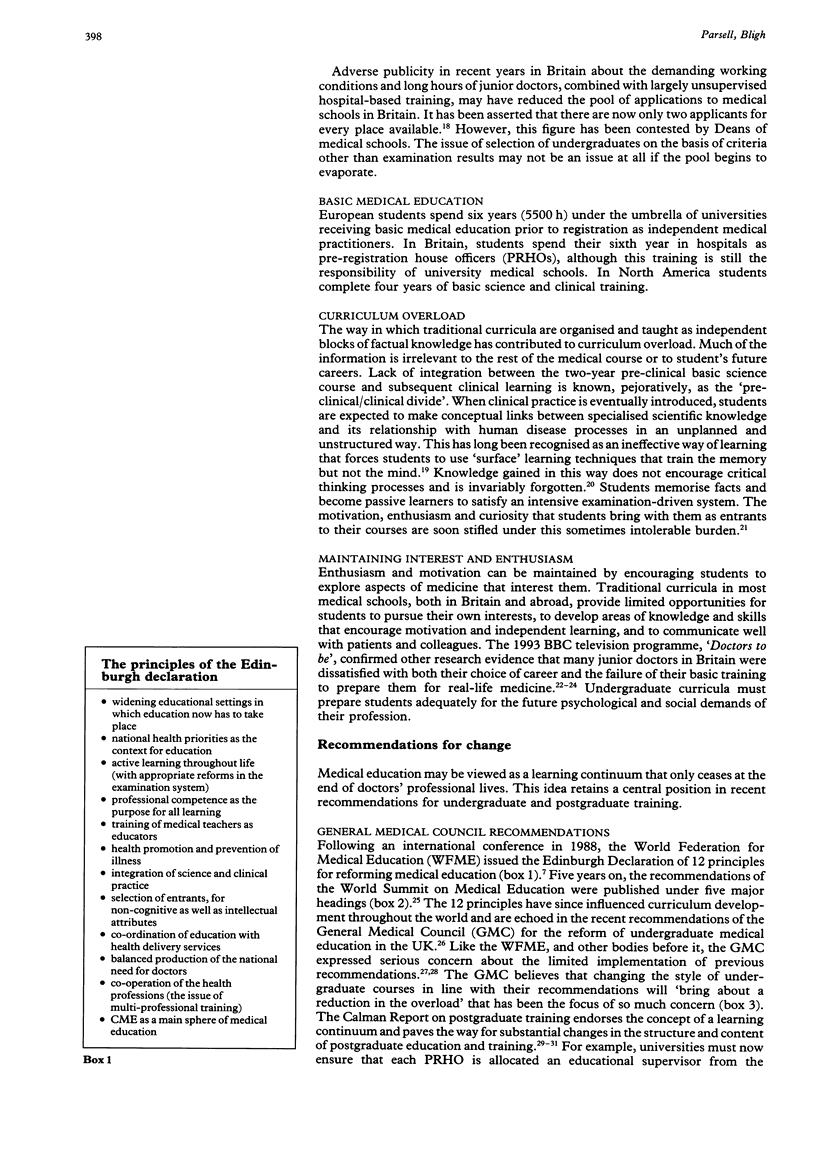
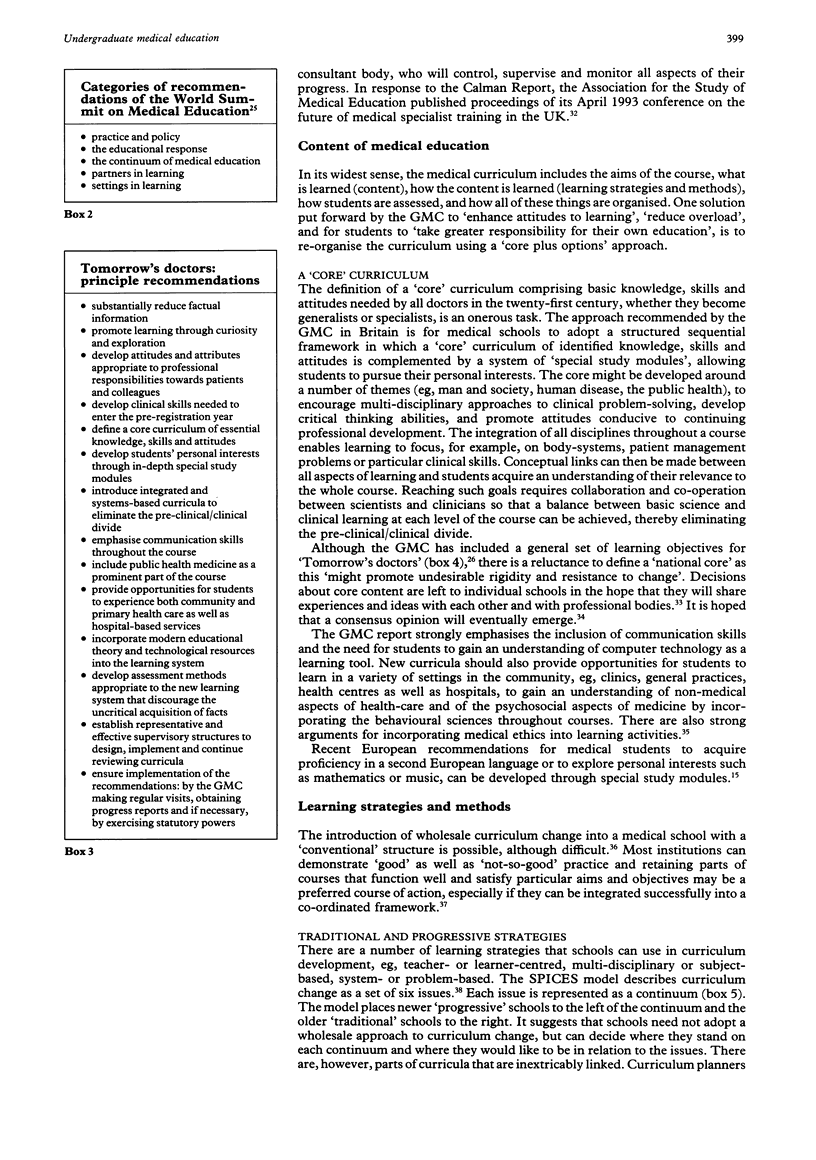
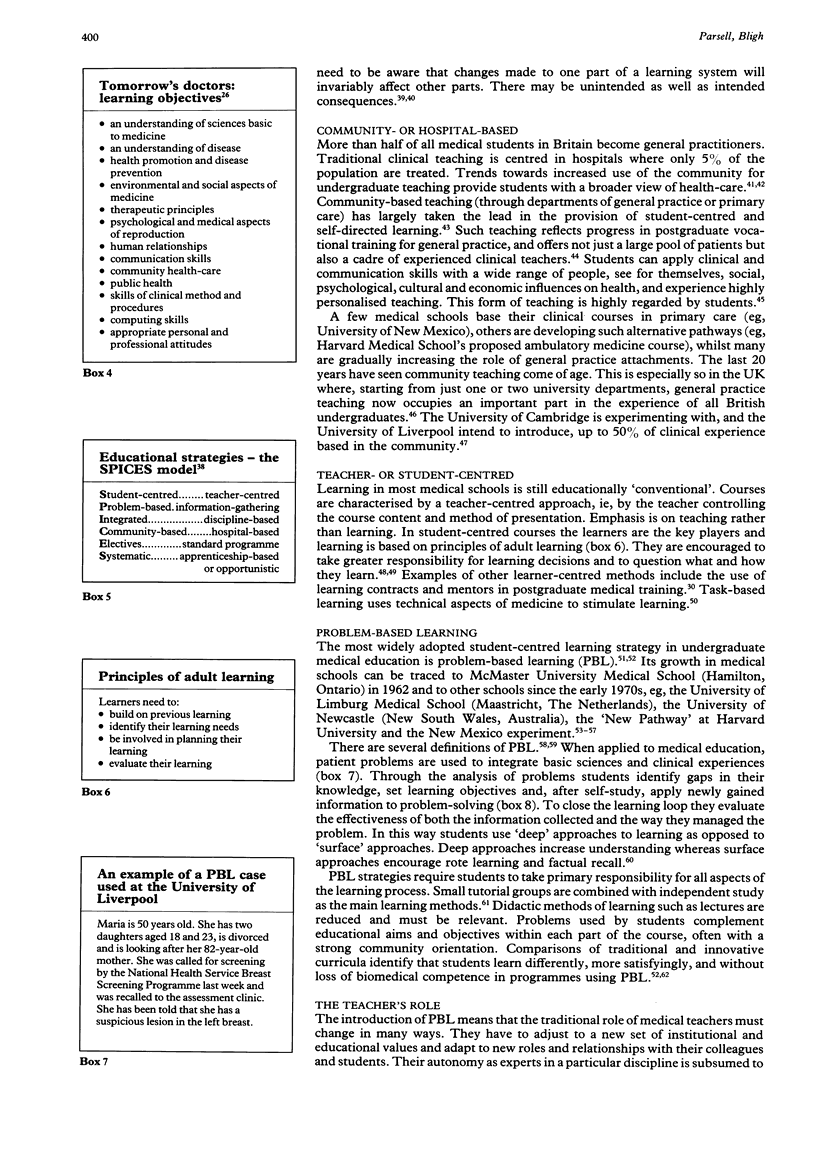
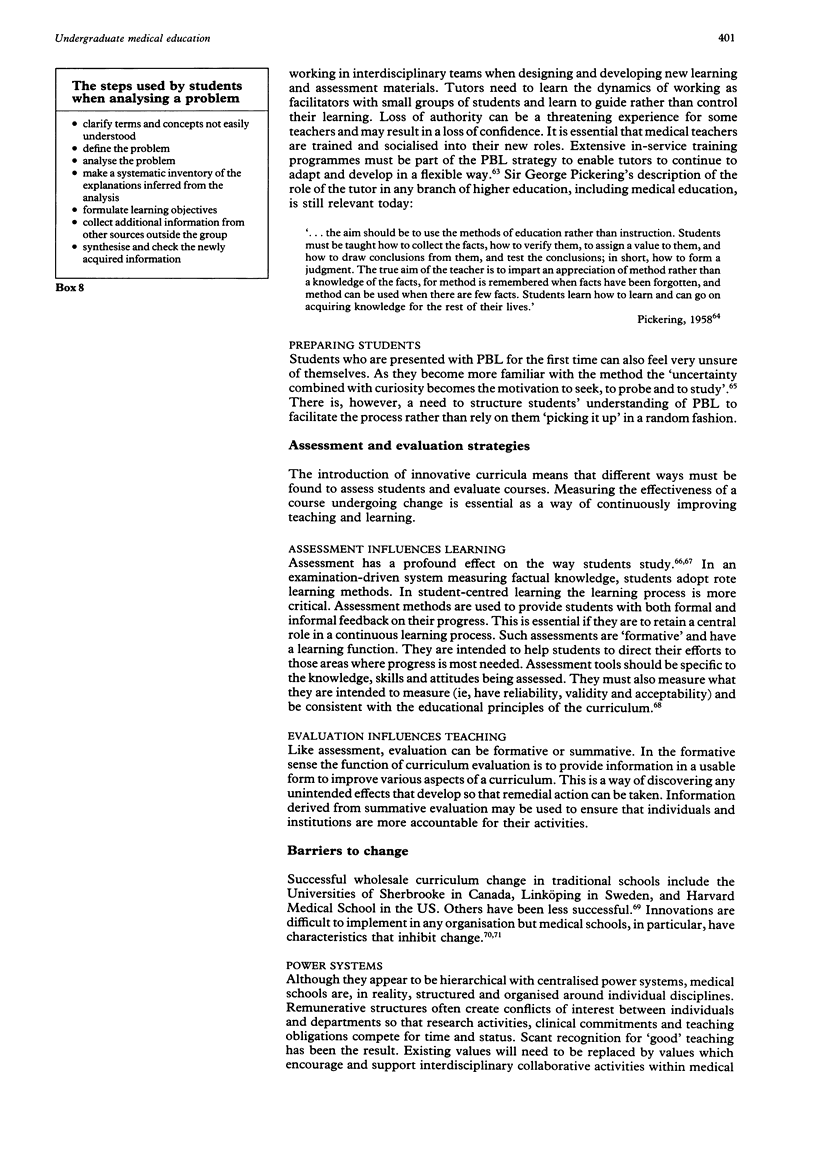
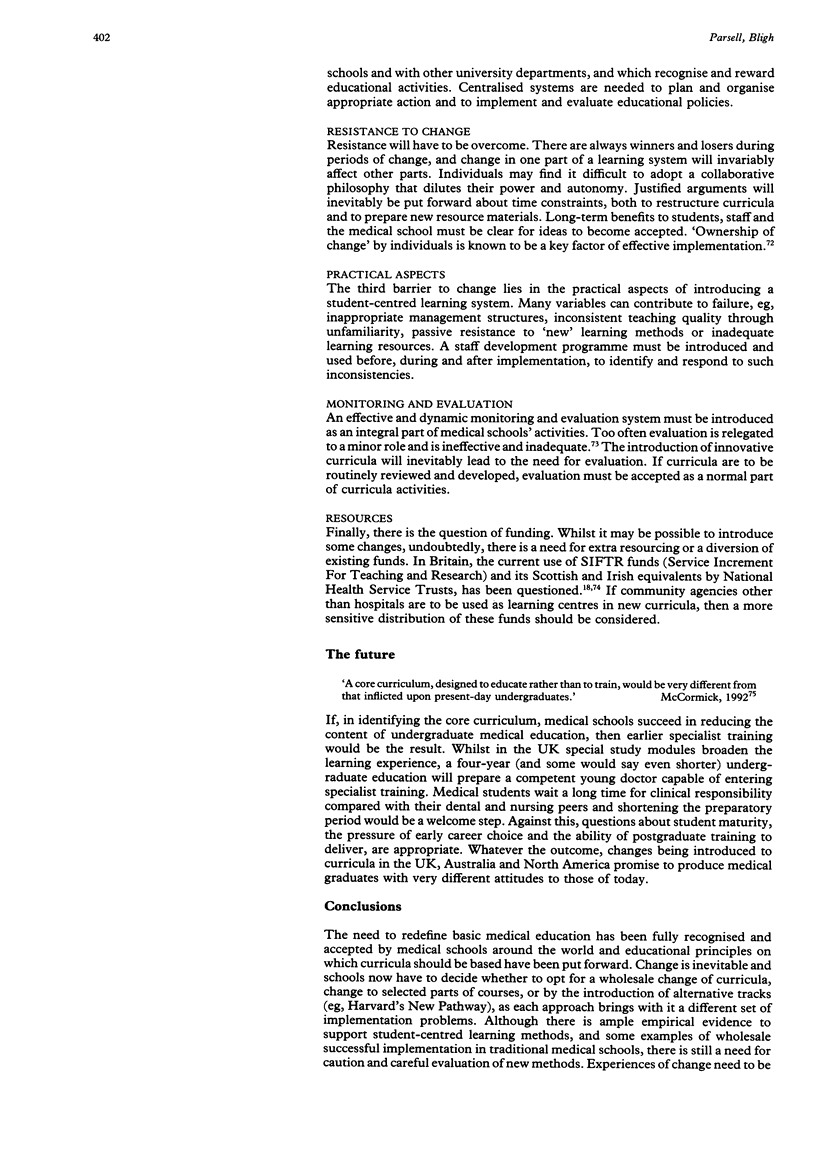
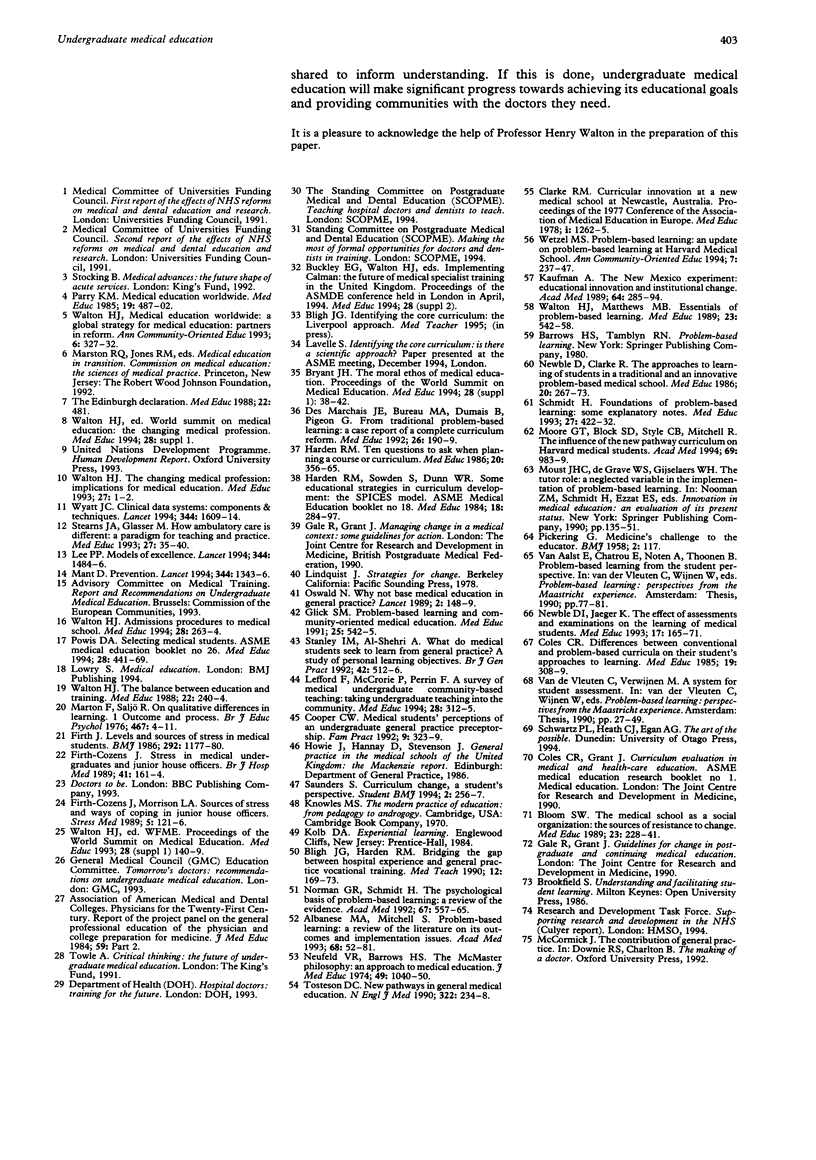
Selected References
These references are in PubMed. This may not be the complete list of references from this article.
- Albanese M. A., Mitchell S. Problem-based learning: a review of literature on its outcomes and implementation issues. Acad Med. 1993 Jan;68(1):52–81. doi: 10.1097/00001888-199301000-00012. [DOI] [PubMed] [Google Scholar]
- Bligh J. G., Harden R. M. Bridging the gap between hospital experience and general practice during vocational training. Med Teach. 1990;12(2):169–173. doi: 10.3109/01421599009006693. [DOI] [PubMed] [Google Scholar]
- Bloom S. W. The medical school as a social organization: the sources of resistance to change. Med Educ. 1989 May;23(3):228–241. doi: 10.1111/j.1365-2923.1989.tb01538.x. [DOI] [PubMed] [Google Scholar]
- Coles C. R. Differences between conventional and problem-based curricula in their students' approaches to studying. Med Educ. 1985 Jul;19(4):308–309. doi: 10.1111/j.1365-2923.1985.tb01327.x. [DOI] [PubMed] [Google Scholar]
- Cooper C. W. Medical students' perceptions of an undergraduate general practice preceptorship. Fam Pract. 1992 Sep;9(3):323–329. doi: 10.1093/fampra/9.3.323. [DOI] [PubMed] [Google Scholar]
- Des Marchais J. E., Bureau M. A., Dumais B., Pigeon G. From traditional to problem-based learning: a case report of complete curriculum reform. Med Educ. 1992 May;26(3):190–199. doi: 10.1111/j.1365-2923.1992.tb00153.x. [DOI] [PubMed] [Google Scholar]
- Firth-Cozens J. Stress in medical undergraduates and house officers. Br J Hosp Med. 1989 Feb;41(2):161–164. [PubMed] [Google Scholar]
- Firth J. Levels and sources of stress in medical students. Br Med J (Clin Res Ed) 1986 May 3;292(6529):1177–1180. doi: 10.1136/bmj.292.6529.1177. [DOI] [PMC free article] [PubMed] [Google Scholar]
- Glick S. M. Problem-based learning and community-oriented medical education. Med Educ. 1991 Nov;25(6):542–545. doi: 10.1111/j.1365-2923.1991.tb00109.x. [DOI] [PubMed] [Google Scholar]
- Harden R. M., Sowden S., Dunn W. R. Educational strategies in curriculum development: the SPICES model. Med Educ. 1984 Jul;18(4):284–297. doi: 10.1111/j.1365-2923.1984.tb01024.x. [DOI] [PubMed] [Google Scholar]
- Harden R. M. Ten questions to ask when planning a course or curriculum. Med Educ. 1986 Jul;20(4):356–365. doi: 10.1111/j.1365-2923.1986.tb01379.x. [DOI] [PubMed] [Google Scholar]
- Kaufman A., Mennin S., Waterman R., Duban S., Hansbarger C., Silverblatt H., Obenshain S. S., Kantrowitz M., Becker T., Samet J. The New Mexico experiment: educational innovation and institutional change. Acad Med. 1989 Jun;64(6):285–294. doi: 10.1097/00001888-198906000-00001. [DOI] [PubMed] [Google Scholar]
- Lee P. R. Models of excellence. Lancet. 1994 Nov 26;344(8935):1484–1486. doi: 10.1016/s0140-6736(94)90295-x. [DOI] [PubMed] [Google Scholar]
- Lefford F., McCrorie P., Perrin F. A survey of medical undergraduate community-based teaching: taking undergraduate teaching into the community. Med Educ. 1994 Jul;28(4):312–315. doi: 10.1111/j.1365-2923.1994.tb02718.x. [DOI] [PubMed] [Google Scholar]
- Mant D. Prevention. Lancet. 1994 Nov 12;344(8933):1343–1346. doi: 10.1016/s0140-6736(94)90698-x. [DOI] [PubMed] [Google Scholar]
- Moore G. T., Block S. D., Style C. B., Mitchell R. The influence of the New Pathway curriculum on Harvard medical students. Acad Med. 1994 Dec;69(12):983–989. doi: 10.1097/00001888-199412000-00017. [DOI] [PubMed] [Google Scholar]
- Neufeld V. R., Barrows H. S. The "McMaster Philosophy": an approach to medical education. J Med Educ. 1974 Nov;49(11):1040–1050. [PubMed] [Google Scholar]
- Newble D. I., Clarke R. M. The approaches to learning of students in a traditional and in an innovative problem-based medical school. Med Educ. 1986 Jul;20(4):267–273. doi: 10.1111/j.1365-2923.1986.tb01365.x. [DOI] [PubMed] [Google Scholar]
- Newble D. I., Jaeger K. The effect of assessments and examinations on the learning of medical students. Med Educ. 1983 May;17(3):165–171. doi: 10.1111/j.1365-2923.1983.tb00657.x. [DOI] [PubMed] [Google Scholar]
- Norman G. R., Schmidt H. G. The psychological basis of problem-based learning: a review of the evidence. Acad Med. 1992 Sep;67(9):557–565. doi: 10.1097/00001888-199209000-00002. [DOI] [PubMed] [Google Scholar]
- Oswald N. Why not base clinical education in general practice? Lancet. 1989 Jul 15;2(8655):148–149. doi: 10.1016/s0140-6736(89)90195-5. [DOI] [PubMed] [Google Scholar]
- Schmidt H. G. Foundations of problem-based learning: some explanatory notes. Med Educ. 1993 Sep;27(5):422–432. doi: 10.1111/j.1365-2923.1993.tb00296.x. [DOI] [PubMed] [Google Scholar]
- Spence A. A. Royal College of Anaesthetists programme. Med Educ. 1994;28 (Suppl 2):38–38. doi: 10.1111/j.1365-2923.1994.tb04591.x. [DOI] [PubMed] [Google Scholar]
- Stanley I. M., al-Shehri A. M. What do medical students seek to learn from general practice? A study of personal learning objectives. Br J Gen Pract. 1992 Dec;42(365):512–516. [PMC free article] [PubMed] [Google Scholar]
- Stearns J. A., Glasser M. How ambulatory care is different: a paradigm for teaching and practice. Med Educ. 1993 Jan;27(1):35–40. doi: 10.1111/j.1365-2923.1993.tb00226.x. [DOI] [PubMed] [Google Scholar]
- The changing medical profession: implications for medical education. A world conference. Med Educ. 1993 Jan;27(1):1–2. [PubMed] [Google Scholar]
- Tosteson D. C. New pathways in general medical education. N Engl J Med. 1990 Jan 25;322(4):234–238. doi: 10.1056/NEJM199001253220405. [DOI] [PubMed] [Google Scholar]
- Walton H. J., Matthews M. B. Essentials of problem-based learning. Med Educ. 1989 Nov;23(6):542–558. doi: 10.1111/j.1365-2923.1989.tb01581.x. [DOI] [PubMed] [Google Scholar]
- Walton H. Admissions procedures to medical schools. Med Educ. 1994 Jul;28(4):263–264. doi: 10.1111/j.1365-2923.1994.tb02709.x. [DOI] [PubMed] [Google Scholar]
- Wyatt J. C. Clinical data systems, Part 2: Components and techniques. Lancet. 1994 Dec 10;344(8937):1609–1614. doi: 10.1016/s0140-6736(94)90409-x. [DOI] [PubMed] [Google Scholar]


